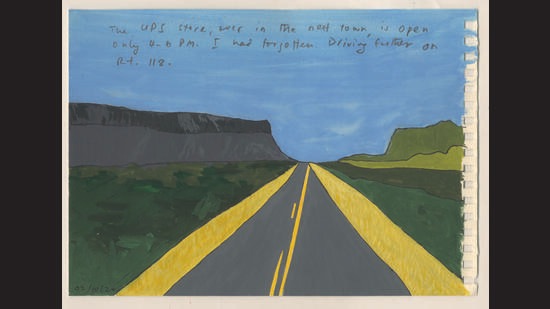MEDIA
Review: The Blue Book - A Writer’s Journal by Amitava Kumar
www.hindustantimes.com | March 25, 2022
Several of the images used in Amitava Kumar’s book were created during a writing residency in Texas to which he was invited. The others record his observations while taking a walk, travels, objects around the house, contemporary occurrences in India, amongst others. A visual expedition into the writer’s mind, Kumar’s paintings in his journal exude a remarkable spontaneity.
Upon opening Amitava Kumar’s The Blue Book – A Writer’s Journal, I was filled with mild envy. Envy caused by Kumar’s drawings and paintings that adorn the book and to me, also constitute its primary strength. Envy also because of his talent for painting and image making which I greatly admire but personally lack. Kumar’s drawings and paintings exude a remarkable spontaneity and a purpose that words often fail to capture. Images are texts after all and in Kumar’s journal, the images speak more eloquently than the little notes that accompany them, which also feel disjointed at times.

153pp, Rs699; Harper Collins.
I am not trying to imply that text accompanying the image has to explain the image or bear a direct correlation. That’s a fallacious enterprise to say the least. Images do not need text. Images are text unto themselves. Images don’t need words to guide their viewing. At this juncture, I would also like to disagree with Ian Jack who is quoted in the book as saying, “Writing is the more difficult and the more honest endeavour” (in comparison with painting or image making). One can think of several painters whose paintings speak more honestly and earnestly than writing or what writing has been able to achieve. Gauguin, Matisse, Arpita Singh, Neelima Sheikh… The list is endless. Open-endedness works in a very different way with images; perhaps even more so than writing.
I am reminded of John Berger here, a rare master who understood both image and word. His writing about images is so effortless and that effortlessness also translates into his prose. Berger’s effortlessness also results from a long and deep meditation and understanding of both worlds. Remember To The Wedding? If you read it closely like several of his other novels, you will see how prose became the image. Kumar is an admirer of Berger too as he mentions in the book.

The author’s images could help us understand the making of fiction. (Amitava Kumar/The Blue Book - A Writer’s Journal)
Several of the images used in Kumar’s book were created during a writing residency in Texas to which he was invited. The others record his observations while taking a walk, travels, objects around the house, contemporary occurrences in India, amongst others. These images could help us to understand the making of fiction – how is a story born, where does plot come from, how does a writer view the world. They may not directly appear in the novel Kumar is writing but they could offer a prompt or guide a certain way of seeing and looking into the world. I wish Kumar told us a little more about what is a visual to him? How does a sight turn into a visual or drawing? Is every visual a stimulus?
Lest we forget, it is Kumar’s journal and a reviewer cannot dictate how it ought to be written but journals are also messy. There’s a lot of cutting and crossing, scribbling, doodling, eliminating the unwanted, finding a voice. I missed that messiness in the images and the accompanying text. This messiness is also linked to the artist’s inner world that we have no access to. We only see the refined work of art – the book, the film, the exhibition but not the elimination that has contributed to the creation. Journal, to me, is that space. Often during art exhibitions or retrospectives, the painter’s journal or diary is displayed for the viewers to understand the process. In comparison, Kumar’s journal produced as a book is neat, orderly, matter of fact.

Amitava Kumar (Michael Lionstar)
Having said that, Kumar’s drawings are wonderful. Especially when Kumar attempts landscape drawings and paintings. In some ways, they remind me of David Hockney and his fascination for landscapes. Kumar’s is not an imitation though but perhaps a shared sensibility. I was also thinking how would this book look without text? What if it had only images? Would that be too experimental for a mainstream publisher like Harper Collins? Would the readers confuse it with an art catalogue?
Perhaps it would have been a different book entirely with images without the interference of text. The book could then potentially turn into an exhibition of sorts – an exhibition that you could house on your book shelf, in your study. You could view the images in any order you like - begin and close at your will. To me, that would have been a more rewarding visual expedition into the writer’s mind, his laboratory.
- Prof. Kunal Ray, Assistant Professor – English Literature.

